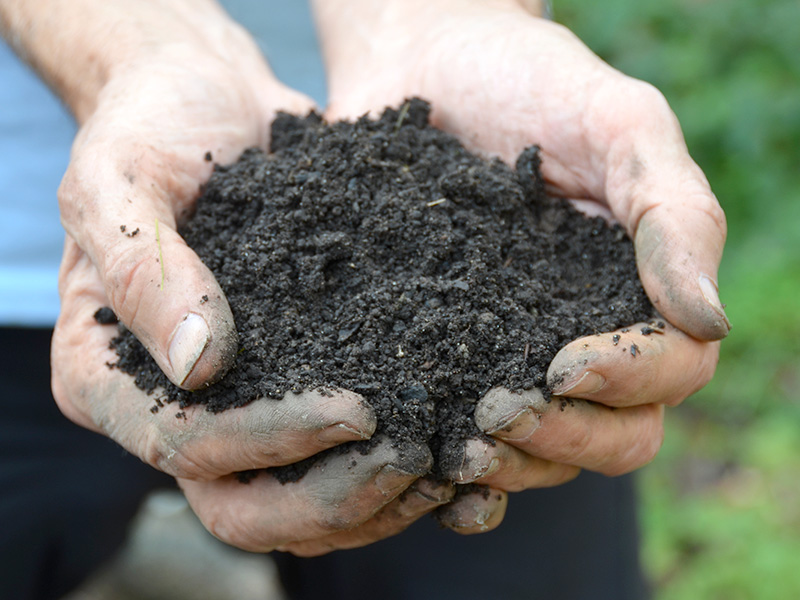
Native plants are essential, but soil is their foundation. But are we as individuals and as a society good stewards of this precious resource? In a human time scale, soil is essentially a non-renewable resource.
It takes up to 1,000 years to form a centimeter of topsoil! We have to nurture it.
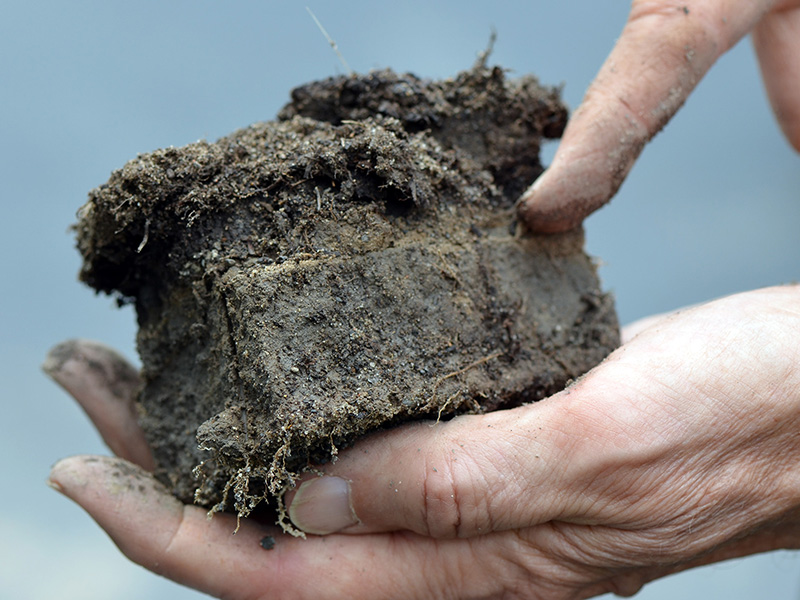
As they say, “Soil sealed is soil lost.” We didn’t expect to have such a vivid demonstration of this idea, but when the town narrowed our road, we were left with a thin layer of sod they “planted” (which immediately died) on top of a thick compressed layer of dead soil that won’t soon be able to support life, if ever.
Unfortunately, in addition to roads, driveways, and house footprints, our suburbs are increasingly sealing soil with hardscaping, swimming pools, and the like. Some yards have little unsealed soil left except for the soil underneath their lawn!
On this page, we talk about how we take care of soil, and we have more information about compost, leaves, and mulch on other pages.
And one of the biggest threats to soil? Non-native worms! Learn more about this issue.
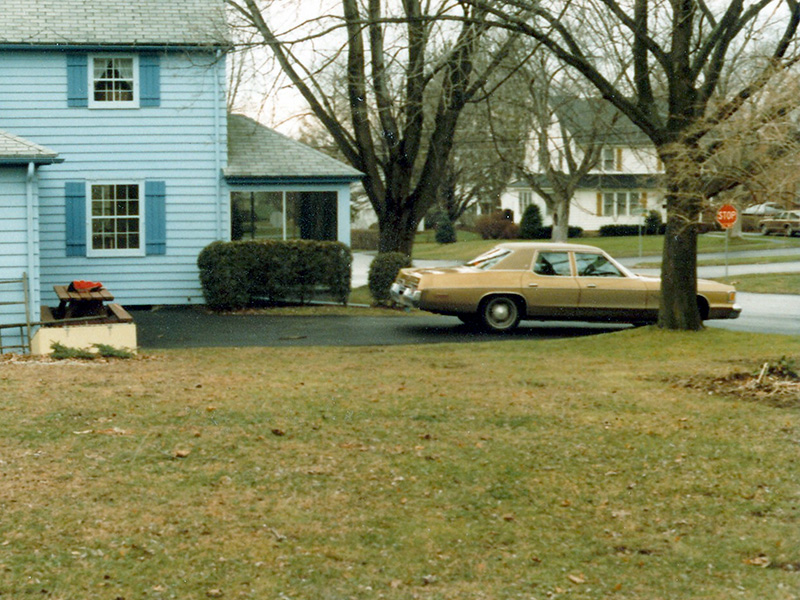
When we went house-hunting, gardening was already a big part of our lives, so we wanted to move to a yard with good soil.
We were probably one of the few people who took a spade with them before deciding whether to buy a property. (We also got a house that came along with the soil!)
Fortunately, we found that what was to become our yard had great soil, having been farmland in the past.
Years later, a woman in one of the clubs that toured our gardens stayed behind after the tour. She said she had grown up in our house and that her father had had it built! She remembered many trips to their farm carrying loads of manure to enrich the soil, so I guess we hit the jackpot.
Even so, if the soil hadn’t been quite so good, we could simply have planted native species suited to poorer soil until the soil gradually improved — an idea we hadn’t learned about yet. At the time (in the early 1980s), besides creating an ornamental garden, we were especially interested in creating an edible garden, which indeed needs good soil.
Leaving leaves
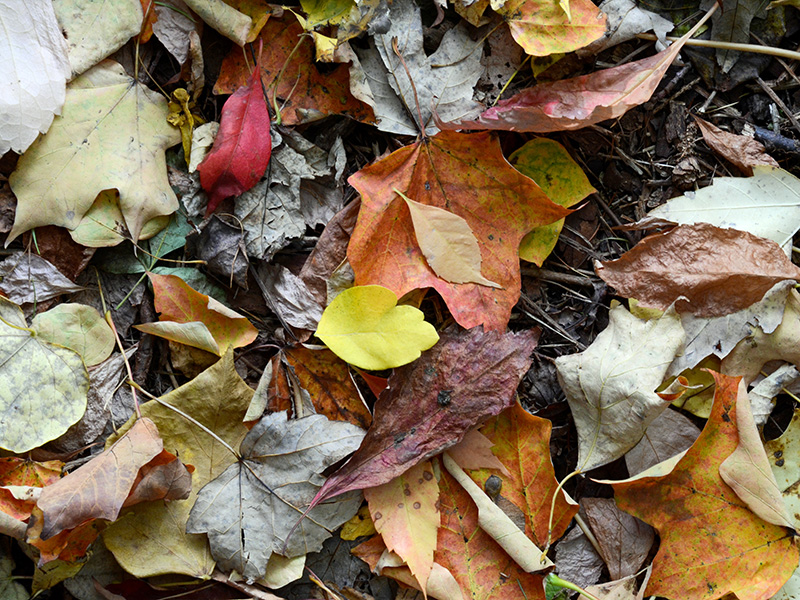
I’m always amazed each spring when I see people so diligently raking up every last bit of dead leaves, twigs, and other bits of nature.
I love seeing the rich variety of nature.
Why is bare ground considered necessary or attractive?
People work hard to create this look, but I don’t understand why.
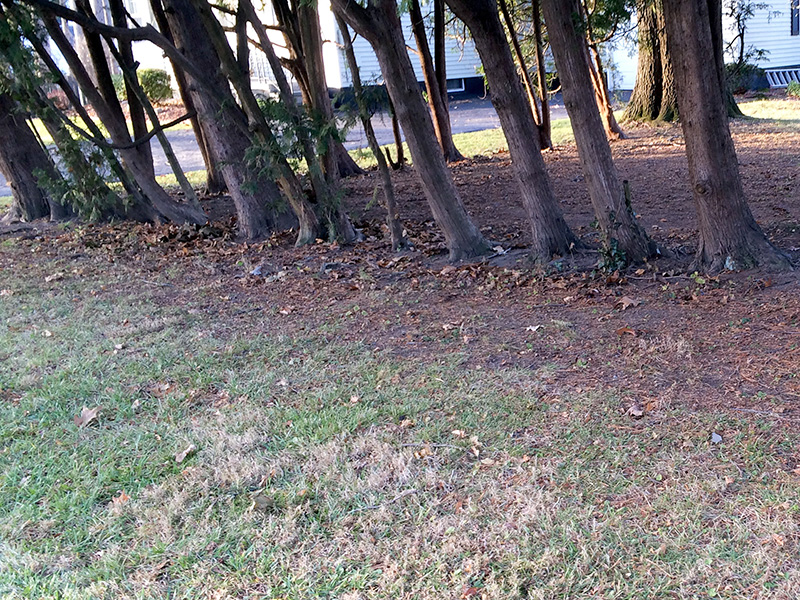
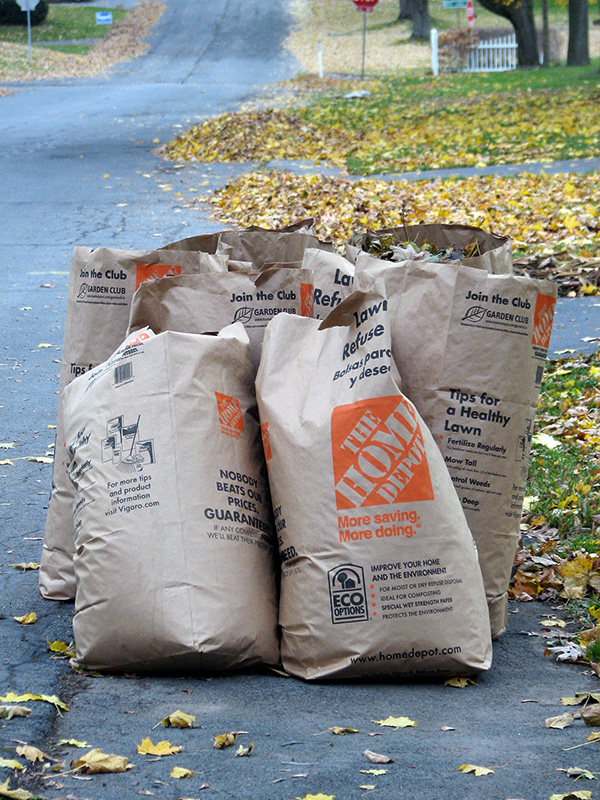
All over our community, people throw out leaves, a valuable resource. This makes no sense!
Plants were meant to grow not just in organic matter, but in the decomposed remains of their own leaves, each species with its unique chemical composition.
And also in those bags of leaves? The pupae of butterflies, moths, and other insects that would have overwintered and emerged in the spring.
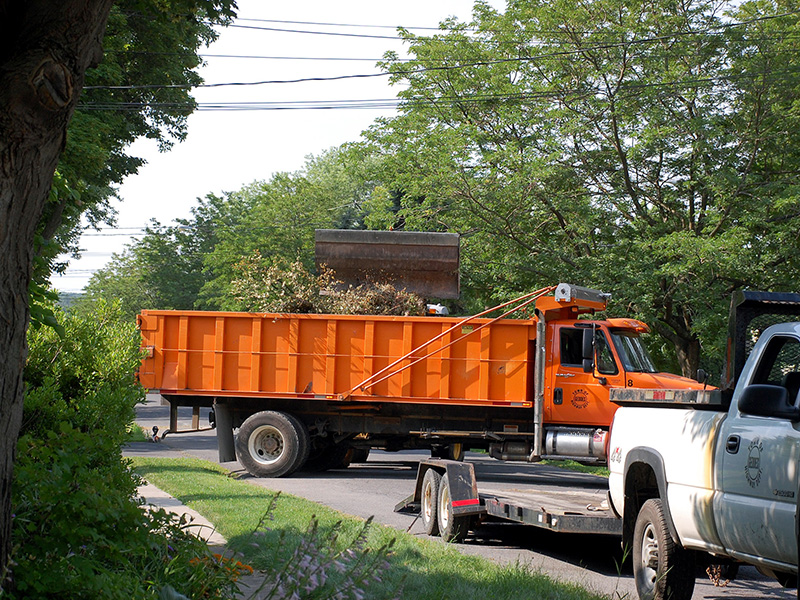
After all, nature doesn’t have garbage trucks that haul old leaves away.
What would happen if the town didn’t collect them?
These leaves would otherwise decompose, continually enriching the soil, and in the meantime providing places for birds to hunt for little bugs, to collect bits of nature for nesting materials and so on.
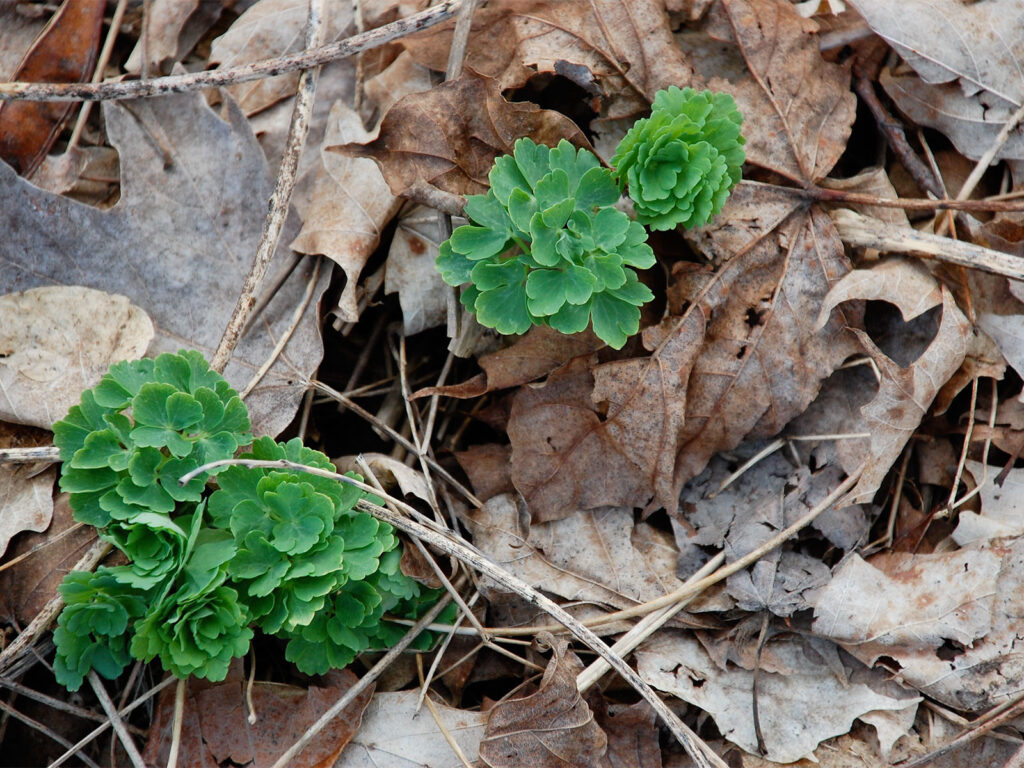
And just as in the wild, our plants find a way to grow through the cover of leaves.
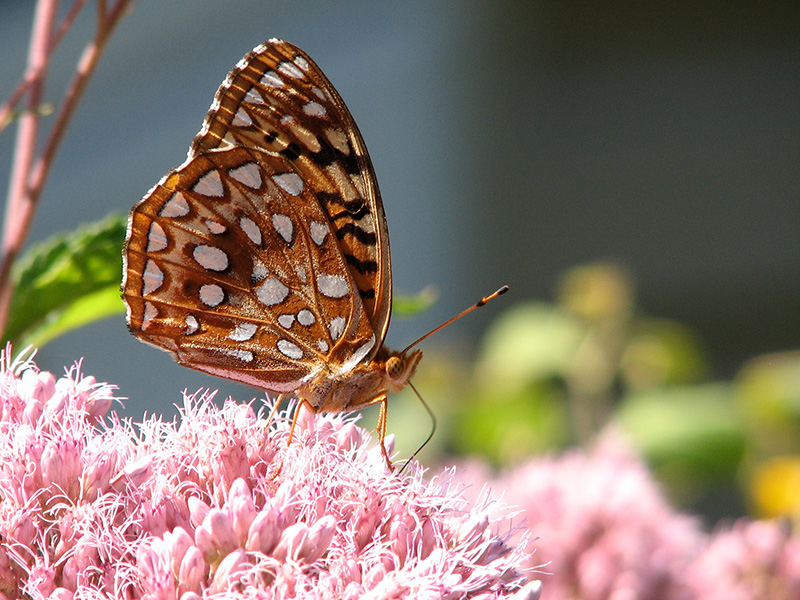
Many butterflies, such as this fritillary, overwinter as larvae in leaf litter.
With so much leaf litter trashed, is it any wonder that there are so many fewer butterflies than in the past?
Birds also depend on this leaf litter since it will have the little bugs they need.
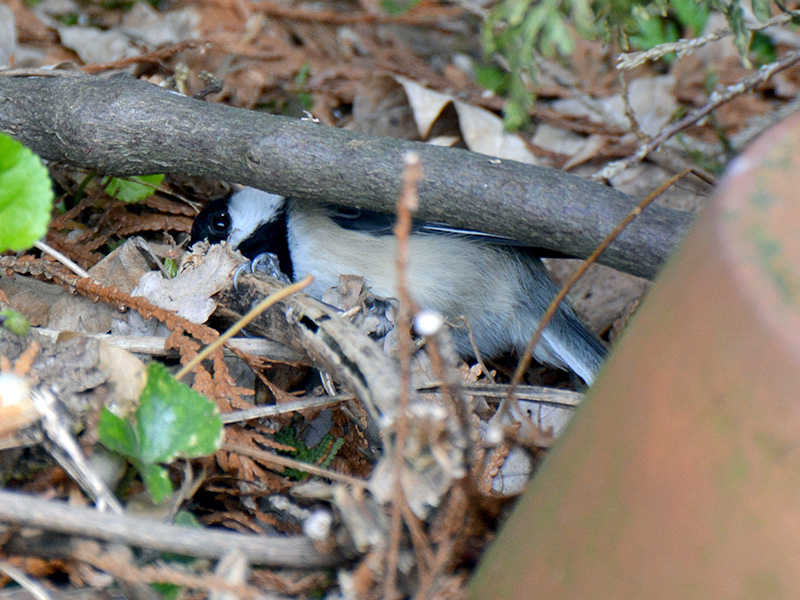
For example, one day we saw this chickadee visiting this “grocery store” — the stalks of dead flowers and other plants we had left to decompose.
We watched him working here for a long time. What could he be looking for?
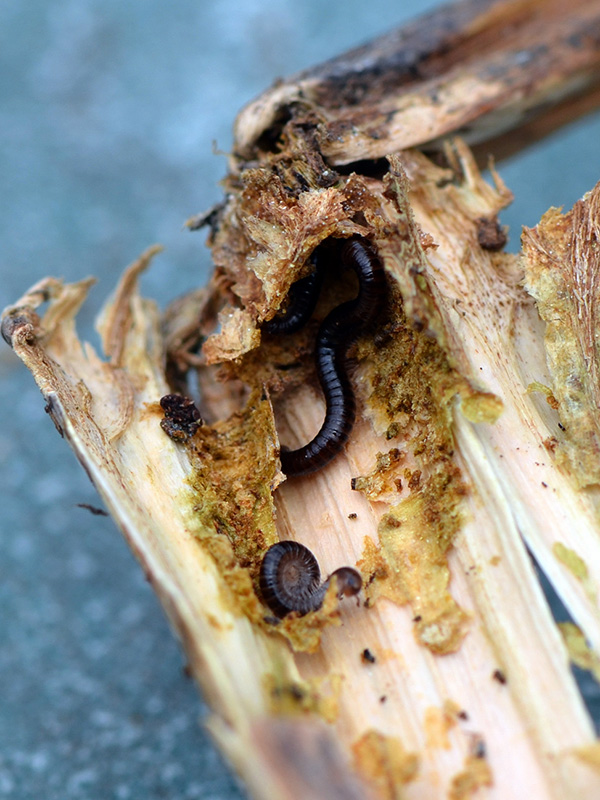
After the chickadee left, we checked out what he was getting from this litter. “Delicious” and nutritious worms!
How much of this important food remains in the typical cleaned-up suburban yard?
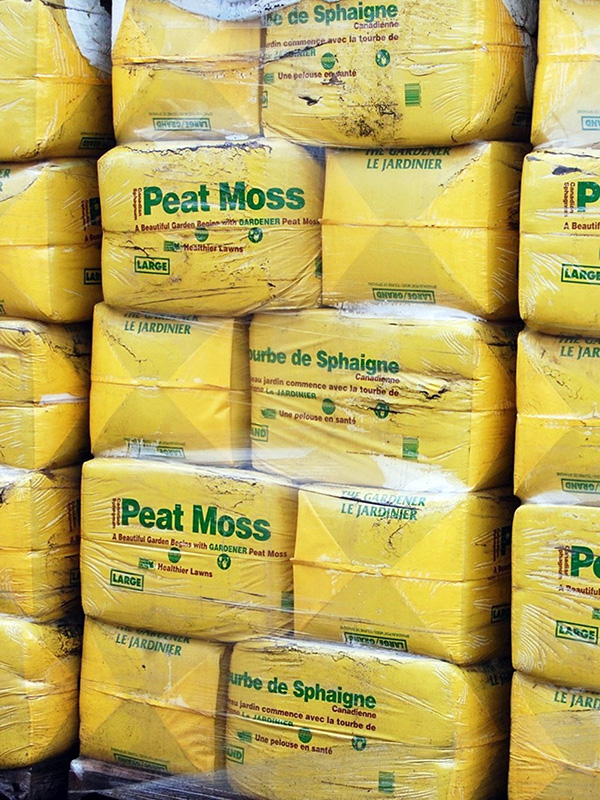
In the past, we routinely bought many bales of peat moss to add to our garden soil. It was a bit expensive, but we wanted the best soil possible.
We later learned that peat moss is a non-renewable resource (at least in any human time-scale). This shouldn’t have surprised us. Less than three inches of peat moss is created in a century! We had been sacrificing ancient peat bogs just to make our own soil a bit better.
We also learned of the important role of peat moss in sequestering CO2, and that peat moss mining releases this CO2 to the atmosphere, a process that continues after mining is done. A climate disaster.
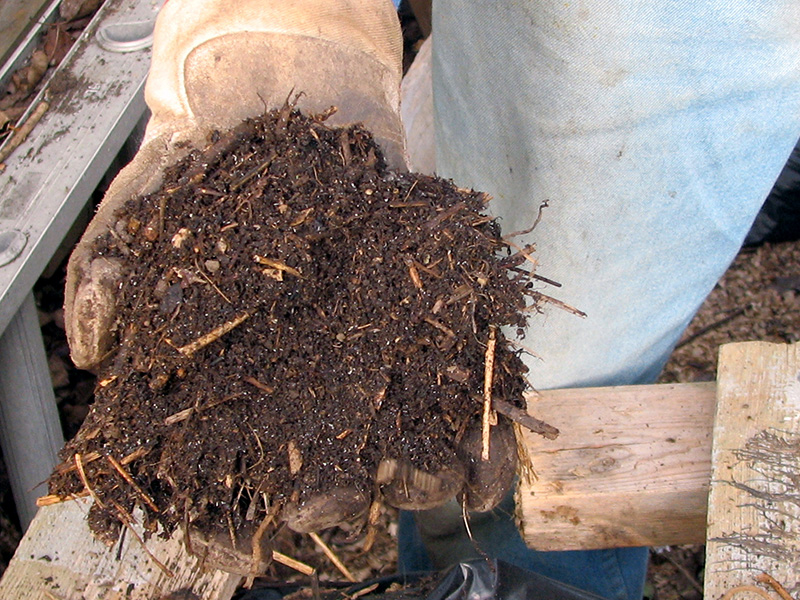
Since then, we haven’t bought any peat moss. Leaving the leaves and limiting digging greatly benefits the soil, and native plants don’t need rich soil anyway.
For our edible garden, we use our garden compost, leaf humus, green manure, and vermicompost — all free, all something we can produce ourselves, and all great for the soil and for our fruits and vegetables. No need for peat moss!
And an environmental (and civic) bonus is that all these materials would otherwise go to the landfill. Even if they were destined to become part of the municipal mulch pile, it takes lot of large fossil-fuel trucks to do so. All in all, we try to keep everything we produce in our yard staying in our yard through its whole life cycle.
Rescuing sod
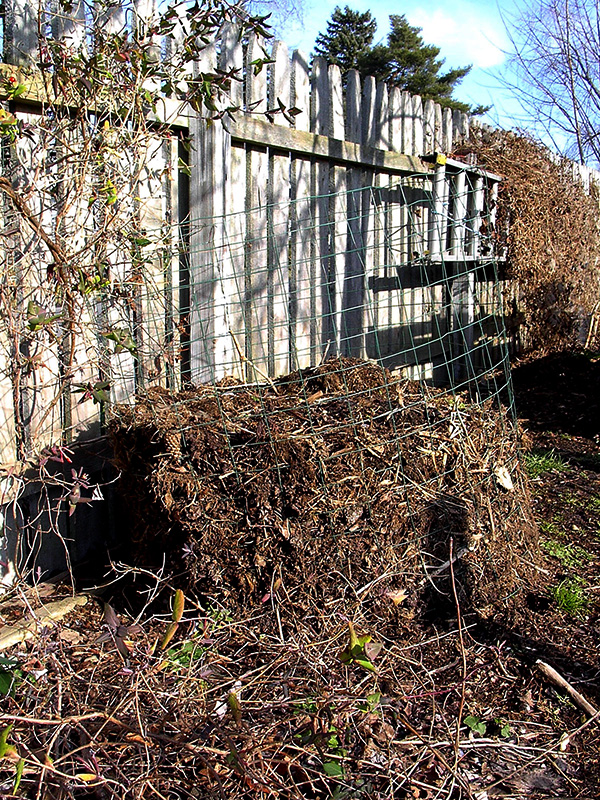
We never throw sod away (though now with our maximally-reduced lawn, we don’t produce sod anymore).
When we initially dug up parts of the lawn (and we didn’t know there was an easier way at the time), we didn’t know what to do with the sod.
We created a homemade “barrel” of fencing and dumped the sod into it until we decided what to do with it.
When we looked at it a year or two later, it was beautiful soil! We were amazed!
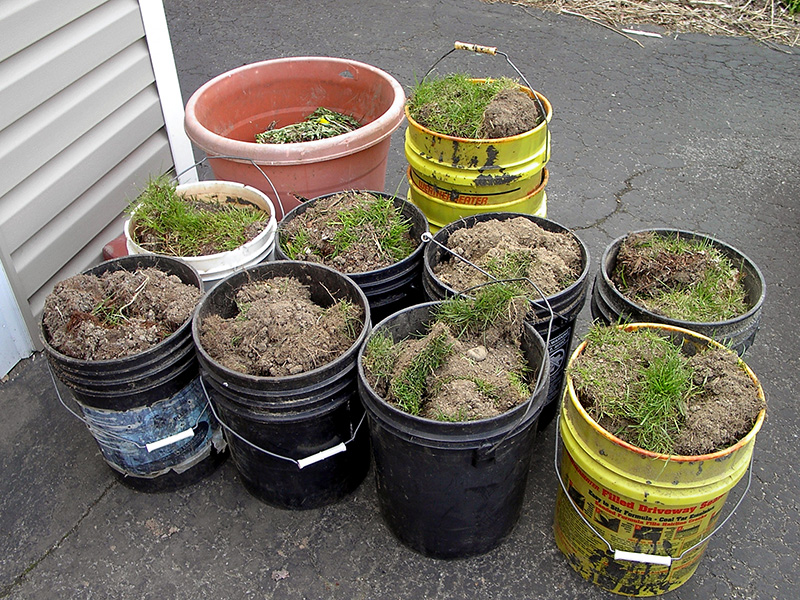
When people install a new fence, edge the lawn etc., they often put piles of sod out to the curb as trash. But this is topsoil, not trash!
We have often collected it (but see Caution below). We always can find a place to put this soil after the sod has composted.
CAUTION: We once found bishop’s weed in some rescued soil! We quarantined it in a pile and watched carefully for any growth for a number of years. We also assume that pesticides had been applied at some point, so we let it “decay” for a while (generally for a few years) and we don’t use it anywhere we’re growing edible plants. In some situations, it may be that this former topsoil might have become too compromised to be worth rescuing.
The planet doesn’t have as much topsoil as we think!
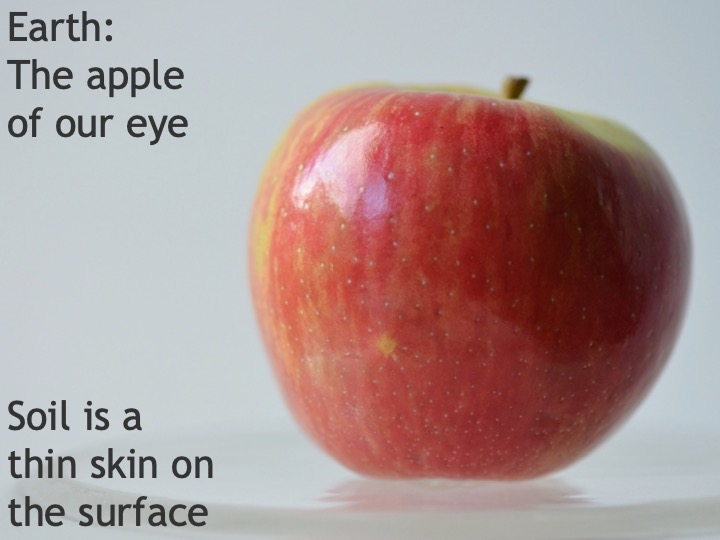
The Soil Science Society of America uses an apple to demonstrate how little topsoil we actually have on our planet.
This is my version of the demo.
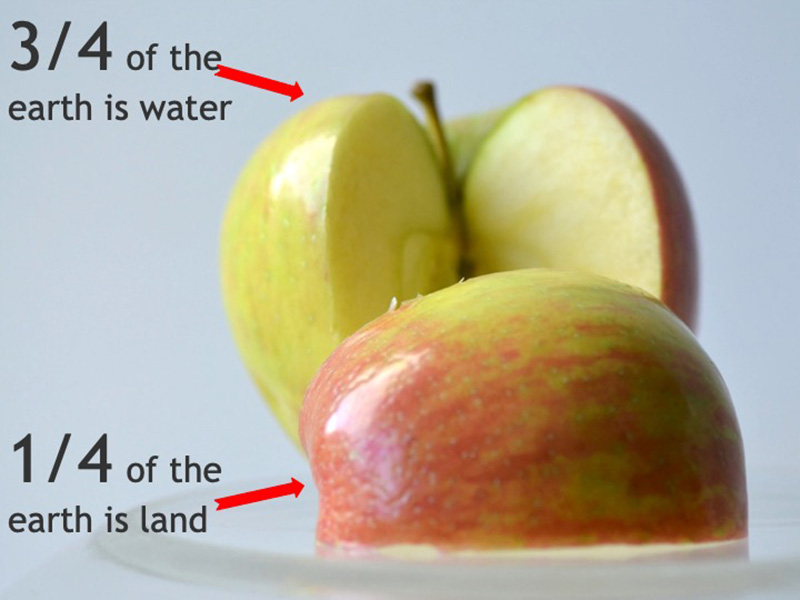
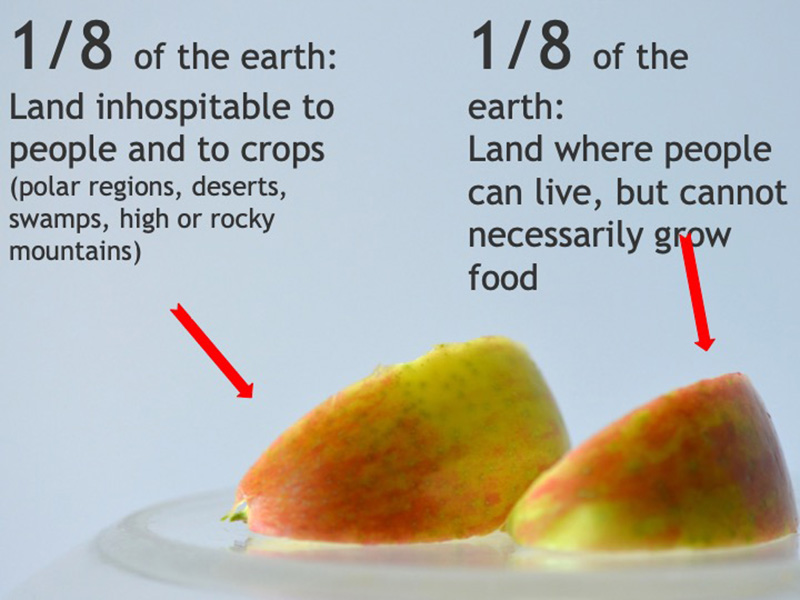
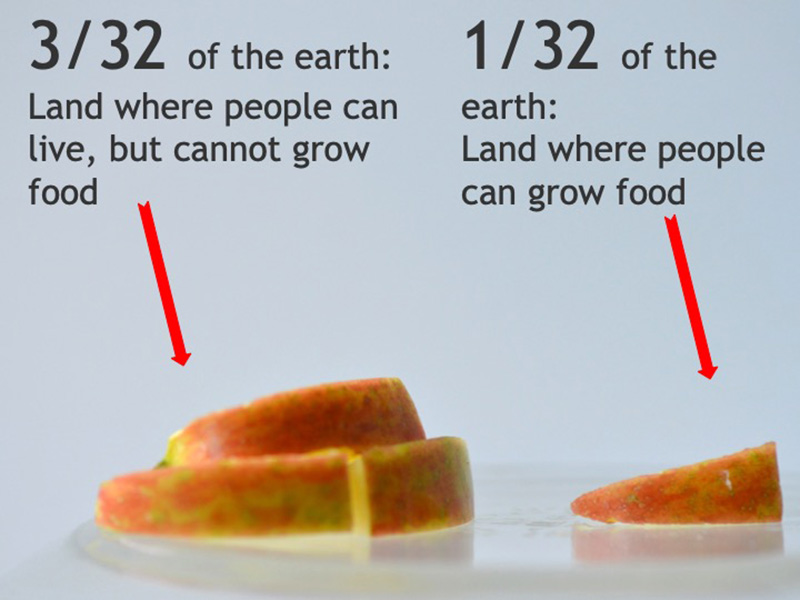
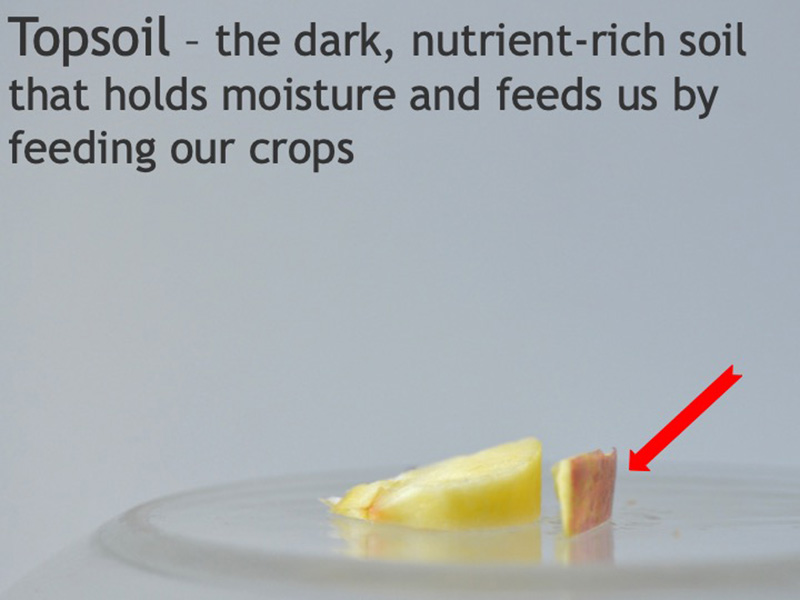
That little piece of apple peel on the right represents all the topsoil on the planet! And this is what is “normal.” Now, so much is eroding away that the U.N. says we have only 60 years worth of topsoil left.
For the sake of future generations, we’d do well to take good care of it!
Resources
- USDA’s NRCS:
- Soil Survey of Onondaga County – describes all the various soils found in our county. (NRCS provides soil surveys for every state.)
- Web Soil Survey – describes all the various soils found in the entire country.
- Massachusetts Office of Energy and Env Affairs:
- Healthy soils action plan (for Mass., but concepts apply to NYS, too)
- Beyond Pesticides:
- Xerces Society:
- Crowther Labs:
- United Nations:
- Re Soil Foundation:
- Grist:
- Yale Environment360:
- The Guardian:
- ‘A poor man’s rain forest’: Why we have to stop treating soil like dirt – NOTE: This is describing soil in England and the benefits of earthworms. They are NOT native here in CNY or other northern areas that had been covered in glaciers.
- Knowable Magazine:
- Symphony of the Soil Project:
- VIDEO: You can watch the trailer and purchase or stream the movie, buy the special interest Sonatas, or watch the free Grace Notes – all beautifully done and informative
- Dirt the Movie Project:
- David Suzuki Foundation:
- Jeff Lowenfels:
- VIDEO: Soil food web lecture – the author of Teaming with Microbes
- Wes Jackson of The Land Institute:
- VIDEO: On Land & Soil – We can now solve the 10,000 year old problem of agriculture
- Soil Science Society of America:
- VIDEO: Dig It! The Secrets of Soil – based on the exhibit we saw at the Smithsonian
- Sustainable World:
- VIDEO: The Soil Solution to Climate Change – on soil sequestering carbon
- Ecological Landscape Alliance:
- VIDEO: Helical piles – protecting trees and soil during construction
Soil and health
- The Atlantic:
- Healthy soil microbes, healthy people – The microbial community in the ground is as important as the one in our guts.
- How to get high on soil
- Our World:
- Nat’l Wildlife Fed’n:
Peat Moss
- David Suzuki Foundation:
- Joe Gardener Show / Growing a Greener World:
- Garden Rant:
- The Real Dirt on Peat Moss – by Ken Druse
- NY Times:
- Washington Post:
- Farmer’s Almanac:
Fungi
- Ecological Landscape Alliance:
- Conservation Int’l:
- Edward Norton is The Soil – Part of the Nature is Speaking series
- TED Talk:
Reflections
Recall, before laying down a mulch of pine bark, that each bush or tree is accustomed to a cover of its own dead leaves below it, and so are the decayers that refeed it. Keep a compost pile for kitchen wastes and cornstalks, but remember that fallen leaves, dead stems, and pulled weeds left in place supply a steadier source of humus than a once-in-a-springtime dole of rotted compost.
~ Sara Stein, Noah’s Garden: Restoring the Ecology of Our Own Back Yards, p. 135
We don’t need to burn peat for fuel. We don’t need it for our gardens. We do need to recognize that peatlands are too valuable to be converted for agriculture or urban development. We must respect, protect and restore the interconnected natural ecosystems that keep us and other species healthy and alive.
~ David Suzuki, David Suzuki Foundation – For climate’s sake, save the peat
Peat bogs and peat lands store vast amounts of carbon. There is no sustainable way to harvest peat. This substance takes hundreds of years to form under special anaerobic conditions, and efforts to restore mined peat fields results in more CO2 being released than sequestered.
~ Sue Reed, Climate-Wise Landscaping, p. 136
A real gardener is not a man who cultivates flowers; he is a man who cultivates the soil … If he came into the Garden of Eden he would sniff excitedly and say: “Good Lord, what humus!”
~ Karel Capek
The nation that destroys its soil destroys itself.
~ Franklin D. Roosevelt
If we pollute the air, water and soil that keep us alive and well, and destroy the biodiversity that allows natural systems to function, no amount of money will save us.
~ David Suzuki
Good landscape stewards need to be good stewards of the soil. The health of soil ecosystems, with all their microbes and macrobes, is key to the vitality of landscape plants. In other words, if you take care of the soil, it will take care of your plants. In addition, a healthy soil sequesters a large volume of carbon in the form of humus and in all the critters that depend on the sugars created through photosynthesis.
~ Sue Reed, Climate-wise Landscaping, p. 138
Man — despite his artistic pretensions, his sophistication, and his many accomplishments — owes his existence to a six inch layer of topsoil and the fact that it rains.
~ Author Unknown
While we live our bodies are moving particles of the earth, joined inextricably both to the soil and to the bodies of other living creatures. It is hardly surprising, then, that there should be some profound resemblances between our treatment of our bodies and our treatment of the earth.
~ Wendell Berry, The Unsettling of America
While the farmer holds the title to the land, actually it belongs to all the people because civilization itself rests upon the soil.
~ Thomas Jefferson
Soil is the tablecloth under the banquet of civilization.
~ Steven Stoll, Larding the Lean Earth, 2002
